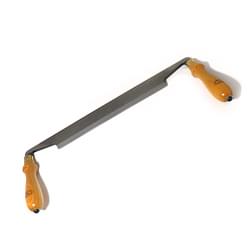




These are the most commonly used Bark Peeling Tools with tips on using them safely and effectively.
by Jim Schmid

Bark spuds remove bark from green logs that will be used in your trail project, slowing the decay process and giving the wood a longer life. The bark spuds have a 1- to 4-foot-long handle and a dished blade with three cutting edges. All three sides should be sharpened on the top side only. The blade slides between the bark and the wood. The best time of the year for removing bark is in the spring.
Safety tip: Push the cutting edge away from your body and keep hands and feet, as well as other workers, away from the front of the blade.
A draw knife is used to strip bark from small-diameter logs or poles for waterbars, turnpikes, and other timber work. Grasp it by both handles and pull the blade along the log toward yourself. A draw knife has handles at a right angle to the blade whereas a bark knife's handles are in line with the blade. Bark knives are meant only for smoothing rough bark-not removing it.
Safety tip: Draw knives are razor sharp, so use caution.
An adze is basically an axe with a curved blade that points inward at a right angle to the handle. It is used to finish (hew) beams and logs to form a flat surface-such as the walking surface of a native log bridge. An adze should be kept very sharp and used only for hewing. It should be handled very carefully and contact with the ground avoided. The blade should always be protected with a sheath.
Safety tip: Exercise caution so as not to cut your feet or shins. When standing on the log being hewed, the toe of your front foot should be elevated so that a glancing blow strikes the bottom of the sole of your boot. Only the back of the heel of the front foot should be resting on the log.
posted Sep 11, 2023
The tools shown here are those used most often by Forest Service trail crews. They are categorized into tools for sawing, chopping, grubbing, digging and tamping, pounding, and hammering, lifting and hauling, peeling and shaping, and sharpening and rehandling. Each tool is described along with helpful techniques for use and maintenance.
Tools for Trails: Measuring and Surveying Tools
posted Nov 8, 2022
Before trail builders start digging, they first have to lay the trail, flag the line, and more to ensure a grade that not only matches the terrain but also is well throughout to prevent erosion.
posted Aug 8, 2022
Let’s talk about grubbing and raking tools! You might have heard the term grubbing before, but if you’re new to trail building, it may be unfamiliar. Grubbing is when you are removing earth and topsoil. Basically digging into the first while removing vegetation in the process. Trail builders may also call this process hogging.
posted Jun 8, 2022
There are a few options for striking tools that you may see out on a project. Some like the sledge hammer will be seen more, while others may only be pulled out for special projects.
18,235 views • posted 04/13/2018